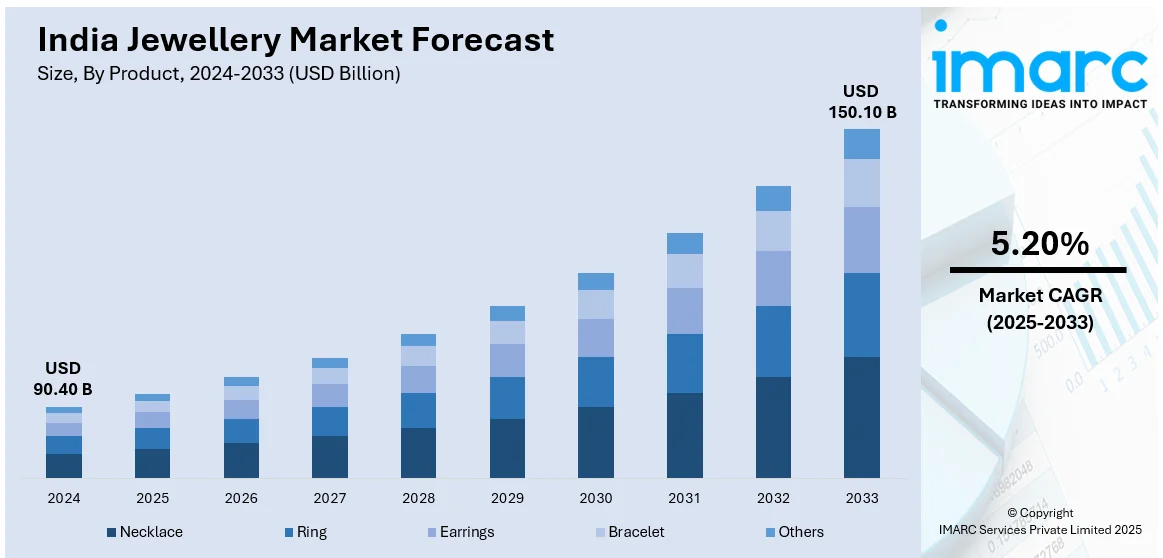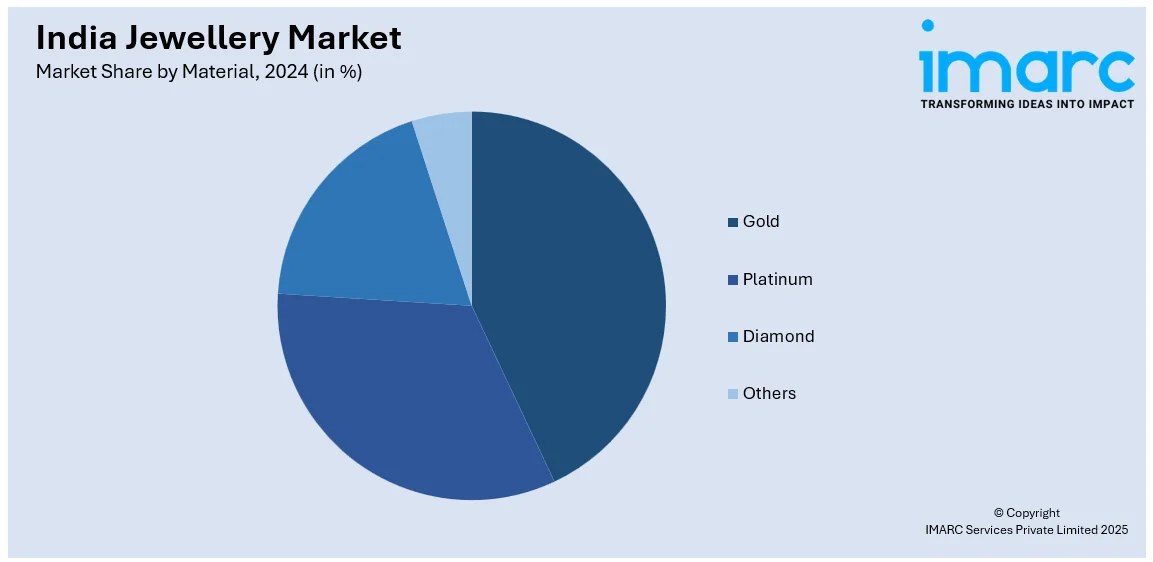
India Jewellery Market Size, Share, Trends and Forecast by Product, Material and Region, 2025-2033
India Jewellery Market Overview:
The India jewellery market size reached USD 90.40 Billion in 2024. Looking forward, IMARC Group expects the market to reach USD 150.10 Billion by 2033, exhibiting a growth rate (CAGR) of 5.20% during 2025-2033. The market is experiencing significant growth, driven by rapid urbanization and high cultural preference for gold and precious stones. The rising demand for wedding jewellery, online shopping, and a move toward branded and modern designs are also driving the India jewellery market growth.
|
Report Attribute
|
Key Statistics
|
|---|---|
|
Base Year
|
2024 |
|
Forecast Years
|
2025-2033
|
|
Historical Years
|
2019-2024
|
| Market Size in 2024 | USD 90.40 Billion |
| Market Forecast in 2033 | USD 150.10 Billion |
| Market Growth Rate 2025-2033 | 5.20% |
India Jewellery Market Trends:
Growing Popularity of Contemporary and Customized Jewellery
A notable trend influencing the market is the increasing demand for innovative and personalized jewellery. Conventional gold and diamond jewellery, although continuing to do well, is being supplemented with modern jewellery meeting the needs of fashion-forward consumers among the Gen Z and Millennials. Millennials and Gen Z prefer personalized, unconventional jewellery, e.g., handmade engagement rings, nameplates, and modern styles employing alternative metal and gemstones. The growth in disposable incomes has enabled more expenditure on one-of-a-kind, statement pieces which communicate personal taste. Brands such as Giva and AuGrav are providing appealing customization choices for Indian consumers. While companies like Nishani, which is India's first fully customizable jewellery brand with more than 30 years of experience in jewellery manufacturing, guarantees that each piece embodies the utmost standards of durability and craftsmanship. Apart from this, the growth in social media platforms where influencer marketing presents customized jewellery has heightened this trend further. Consumers today seek designs which connect with prevailing fashion trends, providing a combination of classic and contemporary aesthetics. Jewelers are meeting this demand by providing customization, increasing the range of products, and implementing new technologies such as 3D printing. These evolving consumer preferences, rising personalization trends, and technological advancements are creating a positive India jewellery market outlook.

Expansion of Online Jewellery Retail
The growth of e-commerce has revolutionized the Indian jewellery segment, with jewellery retail online gaining strong momentum. Consumers, particularly in urban India, are increasingly buying jewellery online because of the convenience and broader range offered. Gitanjali Gems, the leading retailer of diamond and gold jewelry in India, anticipates an increase in online sales, predicting a 20% rise in sales over the next three years, up from approximately 1% in 2024. This expansion has led Ratan Tata, the former chairman of Tata Group, to invest in an online jewelry retailer based in Bangalore, BlueStone, last year. Hence, online jewellery websites such as CaratLane, BlueStone, and Tanishq have popularized jewellery buying, providing a variety of products from classic gold to diamonds and modern designs. This has been driven by rising confidence in shopping online, improved digital payment solutions, and virtual trial of jewellery using augmented reality (AR) technology. Further, online shops offer convenient personalization, price transparency, and doorstep delivery, which attract busy consumers who desire convenience. As people grow more comfortable shopping online, the jewellery market is witnessing a shift from traditional brick-and-mortar stores to online platforms, which is expected to continue to grow in the years to come. This digital transformation is significantly contributing to the expansion of India jewellery market share.
Growing Popularity of Sustainable and Ethical Jewellery
One of the most important trends in the Indian jewelry market is the rising demand for eco-friendly and ethically produced jewelry. With heightened awareness about environmental and social concerns, consumers are increasingly becoming aware of the effect of their spending. This trend is particularly visible among younger generations who are focused on ethical processes in their purchases. Sustainable jewelry is made from recycled materials, ethically sourced gemstones, and conflict-free diamonds, targeting consumers who want to minimize their environmental impact. Also, transparency in sourcing is being embraced by most jewelers, providing certifications to ensure ethical methods. For instance, conventional diamond extraction has generated significant environmental issues since it depends on heavy machinery, explosives, and hydraulic tools to obtain diamonds, a procedure that results in an astonishing 57,000 grams of greenhouse gas (GHG) emissions, generates 2.63 tonnes of mineral waste, and uses 0.48 m3 of water for every carat. Conversely, the emergence of lab-created diamonds signifies an essential move toward eco-friendly practices. These diamonds, possessing comparable physical, chemical, and optical properties to their mined equivalents, are created at a significantly lower environmental expense. Increased growth of brands emphasizing eco-friendly packaging and fair-trade practices is helping drive the transition toward sustainability. With India's wealthy middle class increasing in number and their values changing toward environmentalism, the market for sustainable jewelry is set to grow further.
India Jewellery Market Segmentation:
IMARC Group provides an analysis of the key trends in each segment of the market, along with forecasts at the regional level for 2025-2033. Our report has categorized the market based on product and material.
Product Insights:
- Necklace
- Ring
- Earrings
- Bracelet
- Others
The report has provided a detailed breakup and analysis of the market based on the product. This includes necklace, ring, earrings, bracelet, and others.
Material Insights:

- Gold
- Platinum
- Diamond
- Others
The report has provided a detailed breakup and analysis of the market based on the material. This includes gold, platinum, diamond, and others.
Regional Insights:
- North India
- South India
- East India
- West India
The report has also provided a comprehensive analysis of all the major regional markets, which include North India, South India, East India, and West India.
Competitive Landscape:
The market research report has also provided a comprehensive analysis of the competitive landscape. Competitive analysis such as market structure, key player positioning, top winning strategies, competitive dashboard, and company evaluation quadrant has been covered in the report. Also, detailed profiles of all major companies have been provided.
India Jewellery Market News:
- In November 2024, Tanishq, the jewellery retailer of Tata Group, announced its plans to install De Beers machines in its stores on a trial basis to assist customers in verifying the quality of diamonds. These devices include the SynthDetect XL Plus, designed to assess both set jewelry and loose stones for synthetics, along with DiamondProof - a user-friendly tool aimed at enhancing consumer confidence and knowledge in diamond verification at retail counters.
- In August 2024, Joyalukkas announced its plans to launch an online-only jewellery brand by FY26, targeting younger consumers. Unlike competitors Titan and Kalyan Jewellers, which expanded through acquisitions, Joyalukkas will focus on organic growth. The brand will offer trendy diamond jewellery initially targeting metro and tier-I markets.
India Jewellery Market Report Coverage:
| Report Features | Details |
|---|---|
| Base Year of the Analysis | 2024 |
| Historical Period | 2019-2024 |
| Forecast Period | 2025-2033 |
| Units | Billion USD |
| Scope of the Report |
Exploration of Historical Trends and Market Outlook, Industry Catalysts and Challenges, Segment-Wise Historical and Future Market Assessment:
|
| Products Covered | Necklace, Ring, Earrings, Bracelet, Others |
| Materials Covered | Gold, Platinum, Diamond, Others |
| Regions Covered | North India, South India, East India, West India |
| Customization Scope | 10% Free Customization |
| Post-Sale Analyst Support | 10-12 Weeks |
| Delivery Format | PDF and Excel through Email (We can also provide the editable version of the report in PPT/Word format on special request) |
Key Questions Answered in This Report:
- How has the India jewellery market performed so far and how will it perform in the coming years?
- What is the breakup of the India jewellery market on the basis of product?
- What is the breakup of the India jewellery market on the basis of material?
- What is the breakup of the India jewellery market on the basis of region?
- What are the various stages in the value chain of the India jewellery market?
- What are the key driving factors and challenges in the India jewellery market?
- What is the structure of the India jewellery market and who are the key players?
- What is the degree of competition in the India jewellery market?
Key Benefits for Stakeholders:
- IMARC’s industry report offers a comprehensive quantitative analysis of various market segments, historical and current market trends, market forecasts, and dynamics of the India jewellery market from 2019-2033.
- The research report provides the latest information on the market drivers, challenges, and opportunities in the India jewellery market.
- Porter's five forces analysis assist stakeholders in assessing the impact of new entrants, competitive rivalry, supplier power, buyer power, and the threat of substitution. It helps stakeholders to analyze the level of competition within the India jewellery industry and its attractiveness.
- Competitive landscape allows stakeholders to understand their competitive environment and provides an insight into the current positions of key players in the market.
Need more help?
- Speak to our experienced analysts for insights on the current market scenarios.
- Include additional segments and countries to customize the report as per your requirement.
- Gain an unparalleled competitive advantage in your domain by understanding how to utilize the report and positively impacting your operations and revenue.
- For further assistance, please connect with our analysts.

 Inquire Before Buying
Inquire Before Buying
 Speak to an Analyst
Speak to an Analyst
 Request Brochure
Request Brochure
 Request Customization
Request Customization



.webp)




.webp)












